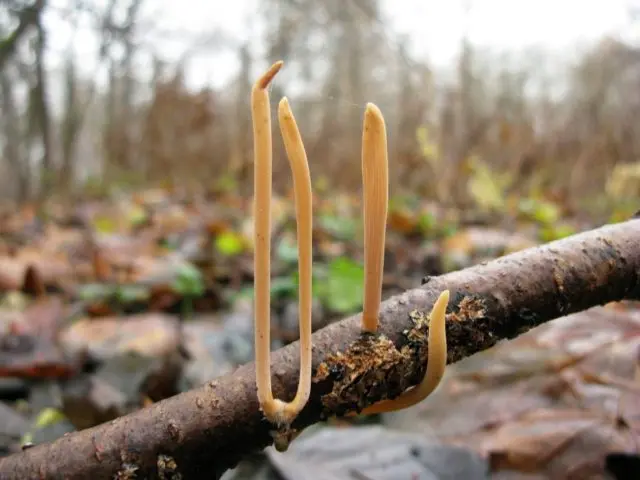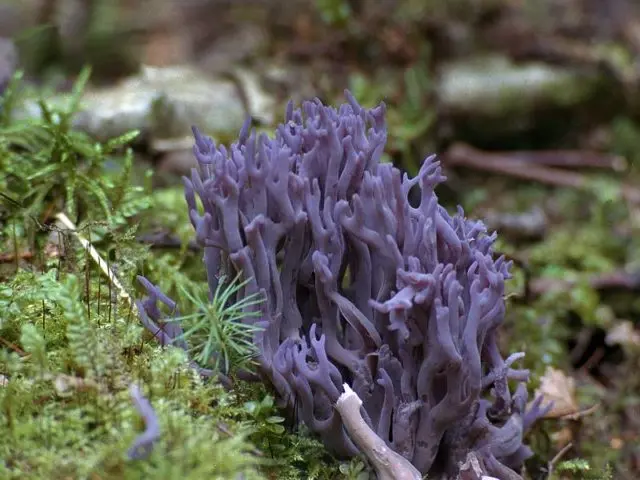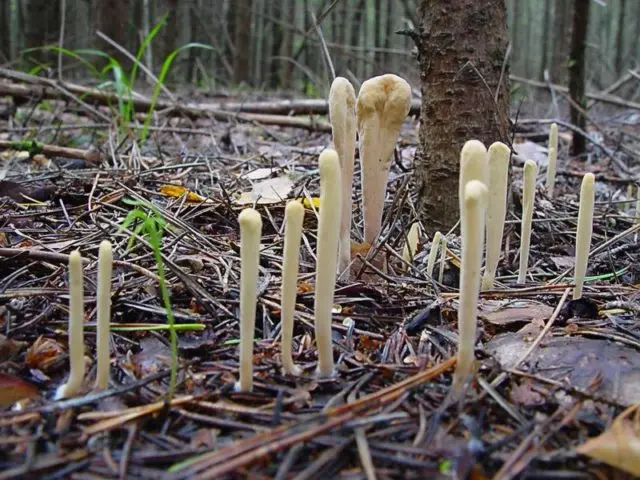Contents
The hornwort is a little-known mushroom belonging to the class Agaricomycetes, the Tifulovye family, the Macrotiful genus. Another name is Clavariadelphus fistulosus, in Latin – Clavariadelphus fistulosus.
Where do fistulas grow
It occurs in deciduous and mixed forests with aspens, birches, oaks, beeches. It grows near paths on grass, on litter of branches and leaves that have fallen from trees, often on beech, rarely on the ground.
The fruiting season is autumn (September, October). Appears in groups or single specimens. It occurs quite rarely.
What do horntails look like
Clavariadelphus fistula has an elongated thin fruiting body, hollow inside, often curved. Its surface is matte, wrinkled, pubescent at the base, covered with white hairs. At first, the shape of the fruiting body is needle-shaped with a pointed apex. In the process of growth, the fungus becomes club-shaped with a rounded top. Its lower part is cylindrical, the upper one is obtuse. Gradually, it acquires a blade-like shape. Sometimes there are specimens with a beveled fruiting body. In height, the horn reaches 8-10 cm, rarely grows up to 15-30 cm. The width at the base is 0,3 cm, at the top – from 0,5 to 1 cm.

The color varies from yellow-ocher to ocher, yellowish-brown or fawn.
The flesh is elastic and dense, cream-colored, exudes a spicy aroma or almost no smell.
Spores are white, fusiform or elliptical in shape. Size – 10–18 x 4–8 µm.
Is it possible to eat fistulous horns
The mushroom is considered conditionally edible, but it is rarely harvested. In some sources, it is marked as inedible due to rare use in food.
The taste of the mushroom
Clavariadelphus fistulosus belongs to the 4th category. It has low taste and low fleshiness. Its flesh is tasteless, rubbery, but with a pleasant smell.
False doubles
A relative of Clavariadelphus fistulosus is the amethyst hornbill. It occurs in deciduous and mixed (coniferous-deciduous) forests. Most often grows singly, sometimes in small colonies, having the shape of a spit. It doesn’t look like a mushroom at all. It is distinguished by a branched fruiting body, resembling a bush or coral, with a bright color – brown-lilac or lilac. Grows on a short stalk or can be sessile. With age, its branches become wrinkled and darken. The flesh is white, turning purple when dry. The amethyst horn is conditionally edible. Its flesh is almost tasteless, with a slight odor. The fruiting season is from late summer to mid-autumn (from August to October).

Another related species of Clavariadelphus fistulosus is the reed hornbill. It occurs quite rarely. It can be found in coniferous and mixed forests. It grows in small colonies on mosses, forming mycorrhiza with them. It got its name because of the shape of the fruiting body – it is tongue-shaped, often slightly flattened. The surface of the body is smooth and dry, becoming slightly wrinkled with age. At first, the surface has a delicate cream color, after maturation, the spores acquire a yellowish tint. The flesh is whitish, dry, almost odorless. Reed hornworm refers to conditionally edible species with low taste. It grows from mid-summer to early autumn (from July to September).

Use
Clavariadelphus fistulosus is rarely harvested for human consumption due to its low culinary value.
Before use, it is recommended to boil for 15 minutes, then the water must be drained.
Conclusion
The hornwort is a rather rare mushroom of the original appearance, practically unknown in Our Country.









